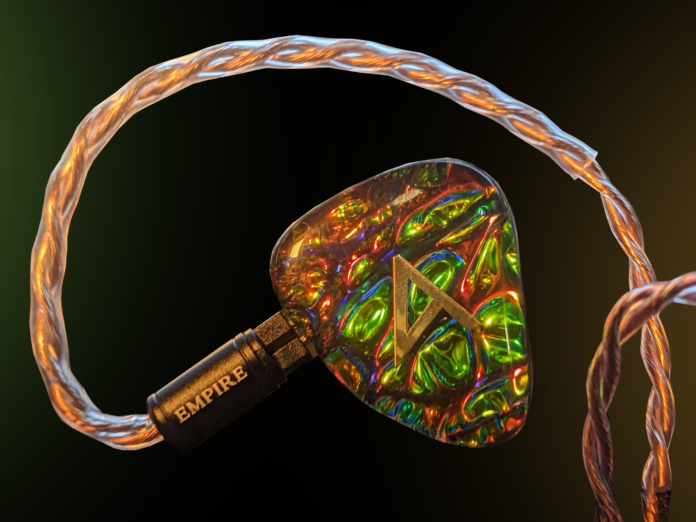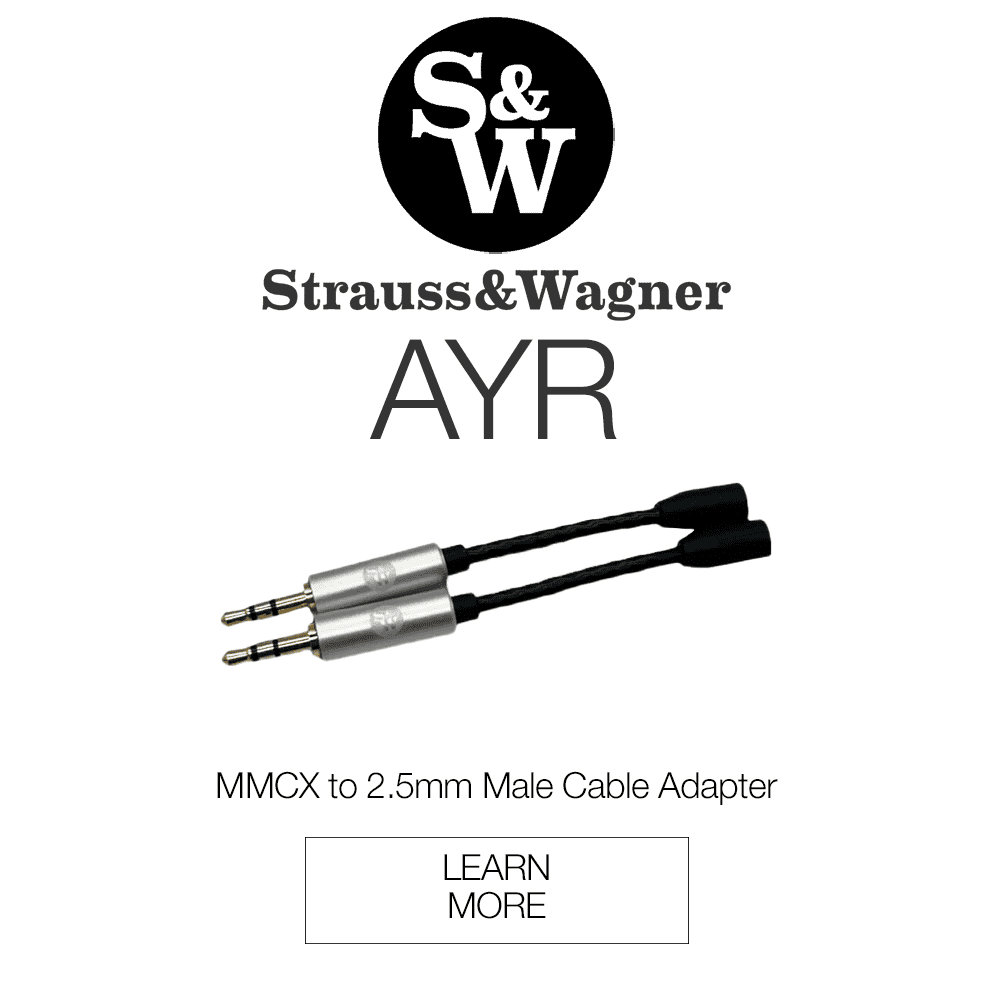Empire Ears x Astell&Kern Odyssey Review
When I see behemoth audiophile companies like Astell & Kern and Empire Ears coming together for an IEM collaboration…I write a review that really needs no introduction. The Odyssey is a $3,399 IEM that comes out of a joint effort between the two companies. Though I’ve tried my fair share of Empire Ears IEMs, and generally come away very impressed, I admit that I have more exposure to Astell&Kern’s DACs than I do their IEMs. I ask the Odyssey the same question I would ask the similarly priced Legend Evo or the Odin: is it really, I mean really, worth its price tag? As usual, let’s take a look in the box, go over some design, talk a bit about bone conduction, and finally, talk about just what the Empire Ears x Astell&Kern Odyssey really sounds like.
What’s In the Box?

- Empire Ears x Astell&Kern Odyssey In-Ear Monitors
- 4.4mm Balanaced Bespoke Effect Audio ARES II UPOCC Coper Litz Cable
- 4.4mm to 3.5mm Pentaconn Adapter
- 5 Pairs of Final Audio Type E Tips
- Aluminum Tip Tray
- Pandora V2 CNC Anodized Black Aluminum Case
- Cleaning Tool
- EE X AK Microfiber Cloth
- Warranty
Look and Feel
Stylistically, the Odyssey is a close relative to the Empire Ears Odin. It features a shimmery, metallic-rainbow faceplate that resembles globs of oil reflecting light on top of water. It’s a standout look, and you probably won’t get away unnoticed if you wear them in public. For one last note on look, as you can see the Odyssey for yourself and come to your own conclusions, I find the copper litz cable to provide a nice neutral contrast to the IEMs bold and flashy color scheme.
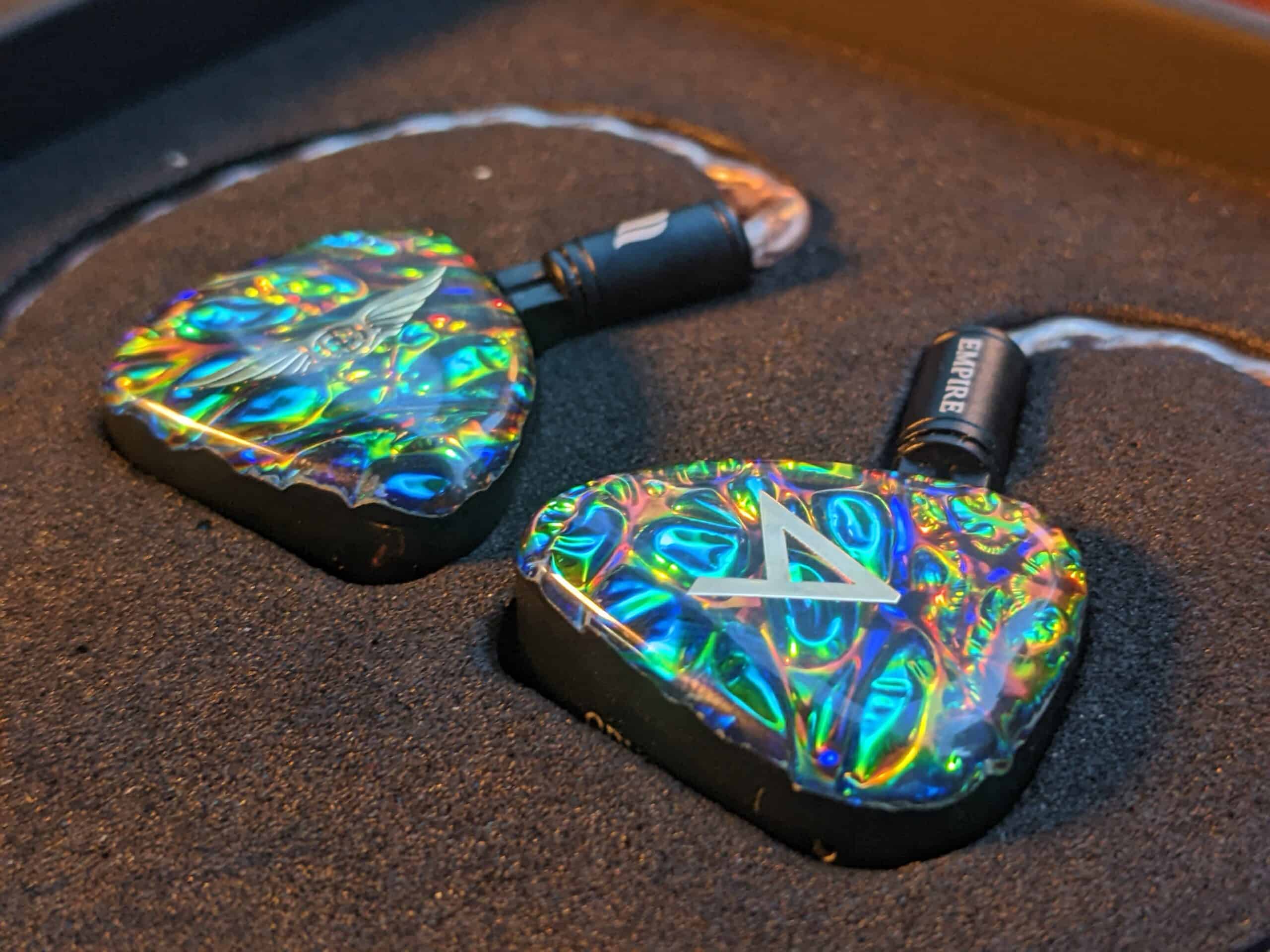
Fit wise, they’re about as chunky as one might expect from an IEM packed with 10 drivers. This isn’t to say they were uncomfortable: they lightly bulged against my ear’s cartilage, but sat securely in my concha with solid passive isolation. The fit is somewhat deep, though won’t lobotomize you like some IEMs in this price range. My ear canals are fairly asymmetrical, but I found the Empire Ears x Astell&Kern Odyssey filled them evenly and required minimal nudging once I had them set in place.
As usual from Empire Ears, we see a hard, metallic carrying case with a screw-on lid, and an additional small, mesh pouch to pad the IEMs from clunking around in the hard case. I’m a big fan of the Empire Ears cases, and I think every IEM that costs this much deserves the protection that these cases offer.
Technical Design and Specs
We see a 10 driver configuration in the Empire Ears x Astell&Kern Odyssey. Twin W9+ subwoofers are delegated for sub and mid bass, 5 balanced aramtures for the mid range, dual electrostatic drivers for the highs and “ultra highs,” and the star of the show, a W10 bone conductor driver, working all throughout the frequency spectrum. I sometimes feel a little alone in my enthusiasm for for bone conductor drivers (not very many IEMs feature them, yet), so give me a moment to geek out here:
The range of human hearing is generally 20 Hz – 20 kHz, but can be expanded via methods such as bone conduction. So, what’s the W10 driver really doing? Vibrations forgo air conduction, and thus the ear drum, and are transmitted via ossicles (bones in the middle ear) which then vibrate the cilia of the inner ear. An example of naturally occurring bone conduction would be submerging your head under water, with the water acting as the conductive medium. In fact, humans have been recorded hearing sounds as high as 100 kHz underwater – more than 2 octaves higher than our usual limitations. This makes the Odyssey’s frequency response of 5 Hz – 100 kHz a little more relevant than it is in IEMs that rely solely on air conduction.
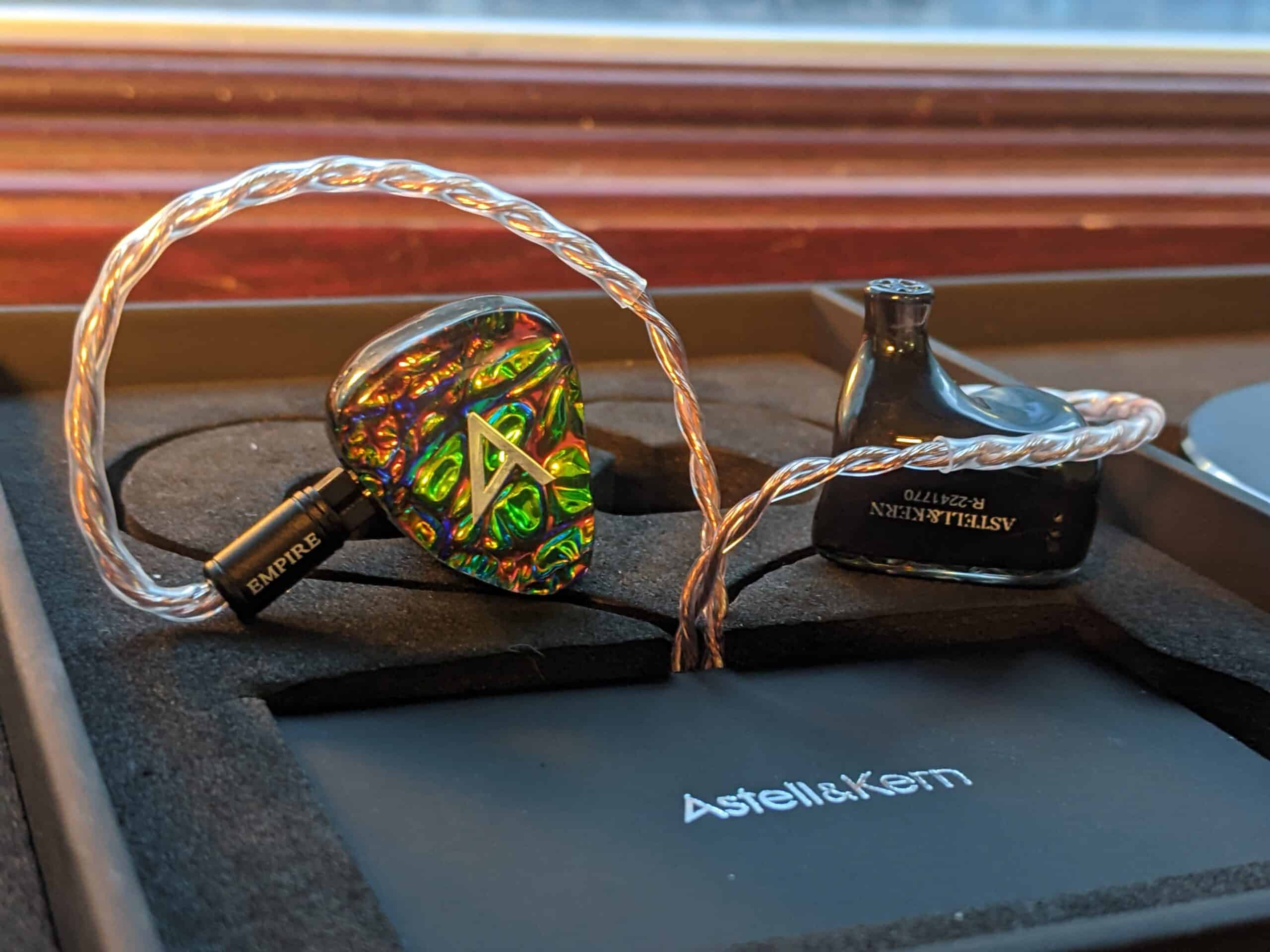
Anyway, let’s reign it back in a little. The Empire Ears x Astell&Kern Odyssey makes use both bone conduction and air conduction to achieve its sound and, as I’ll get into shortly, rattle your head off of your neck.
| Spec | Empire Ears x Astell&Kern Odyssey |
| Drivers | (2) W9+ Subwoofers, (5) BA, (2) EST, (1) W10 Bone Conductor |
| Frequency Response | 5 Hz – 100 kHz |
| Impedance | 2.1 ohms |
| Sensitivity | 100 dB |
Soundstage
From my first listen to my last, I was pretty amazed by the extremely forward facing stage offered in the Odyssey. Mono parts such as vocals were unmistakably felt as if the musicians were standing in the room, directly in front of me. Even hard pans maintained an out-in-front distance, gently moving towards my sides on a soft curve. However, there’s another element to the imaging that’s genuinely unique and unlike the vast majority of IEMs, or headphones, on the market. This is due to, yup, you guessed it, bone conduction. I felt bass frequencies literally oscillating between my jaw and my cheekbones and even running down my neck. The Odyssey has an impressive enough holographic image like you would hear from other high end IEMs, but stands out for blurring the line between audibility and tactility in its imaging with its bone conduction. While the holographic image stands out in front of you, the “physical image” is reaching around to the back of your head.
Lows
On my first couple of listens with the Odyssey, there was a mysterious force that grabbed me by the head and pushed me down into my chair. Was it high bass? No, it’s mid bass. Wait, no, its some of the deepest sub bass I’ve ever heard (felt, rather) from an IEM. The dual subwoofers and bone conductor driver are working overtime here, shoving sub bass vibrations into my cheekbones and skull – even my shoulders, though more subtly. I wanted to bathe in this low end, and did, when I listened to “Sin dones” by Juana Molina, a track which features heavy, dueling basses. What I found equally as impressive as the low end’s sheer power is its detail, as the Odyssey had no problem keeping the competing bass lines sounding distinct and separate from one another. Sometimes balances that bonk listeners on the head with bass lose clarity in the midst of amplitude, leaving low end timbres to sound like fat, ambiguous sine waves. Though I’m pleased to say that the Empire Ears x Astell&Kern Odyssey retained a high sense of tonal and textural low end detail in the midst of its power, this is also exactly what I would expect from a bass-monster IEM that costs $3,399.
To stay true to the product, I’m writing this review based on my experience with the provided silicone tips. However, if you find yourself with the Odyssey in your possession, I recommend using your favorite foam tips to make the most of the bone conductor and subwoofers.
Mids
Though this is a mids balance that can be generalized as “V” shaped, there are a few additional characteristics that define it. Low mids see a modest boost, just enough to make them, perhaps arguably, the prominent component of the mids balance. The opening acoustic guitar strums on “Wading In Waist High Water” by Fleet foxes had their thicker fundamentals brought out a bit more than their picky-transients. However, vocals seemed to gravitate more to the high-mid side of the “V,” coming off a little lighter with more emphasis on their midrange overtones. Despite whatever preconceptions you might hold about V shaped mids, I didn’t hear any mid range casualties, or really feel any particularly strong feelings towards it.
Highs
Treble balance comes across as safely Harman-like, but with a little extra crisp extension in the high treble. Generally speaking, I would describe the high-frequency balance as semi-neutral, detailed, and lifting. I liked hearing this high end tuning in the Odyssey, as it allowed it to be a bass heavy IEM without succumbing to a dark balance (nothing against dark balances, just not my usual preference). Hi-hats land in the churning currents of the low end balance with a little extra point, and reverbs are granted a high-resolution, airy quality. I didn’t suffer from any peaky harshness, and find it to be a Goldilocks sort of high frequency tuning that wont stir much criticism from those who are cautious, or keen, on treble.
Other Notes
The Odyssey is pretty far from a natural balance – it’s heavily colored, but that’s by design and part of its appeal. Its low end is certainly boosted to a point where bass lines might become prominent parts of tracks whereas they wouldn’t be on a different pair of IEMs. The Empire Ears house sound is entirely present here, whether or not you like it is obviously a point of subjective preference.
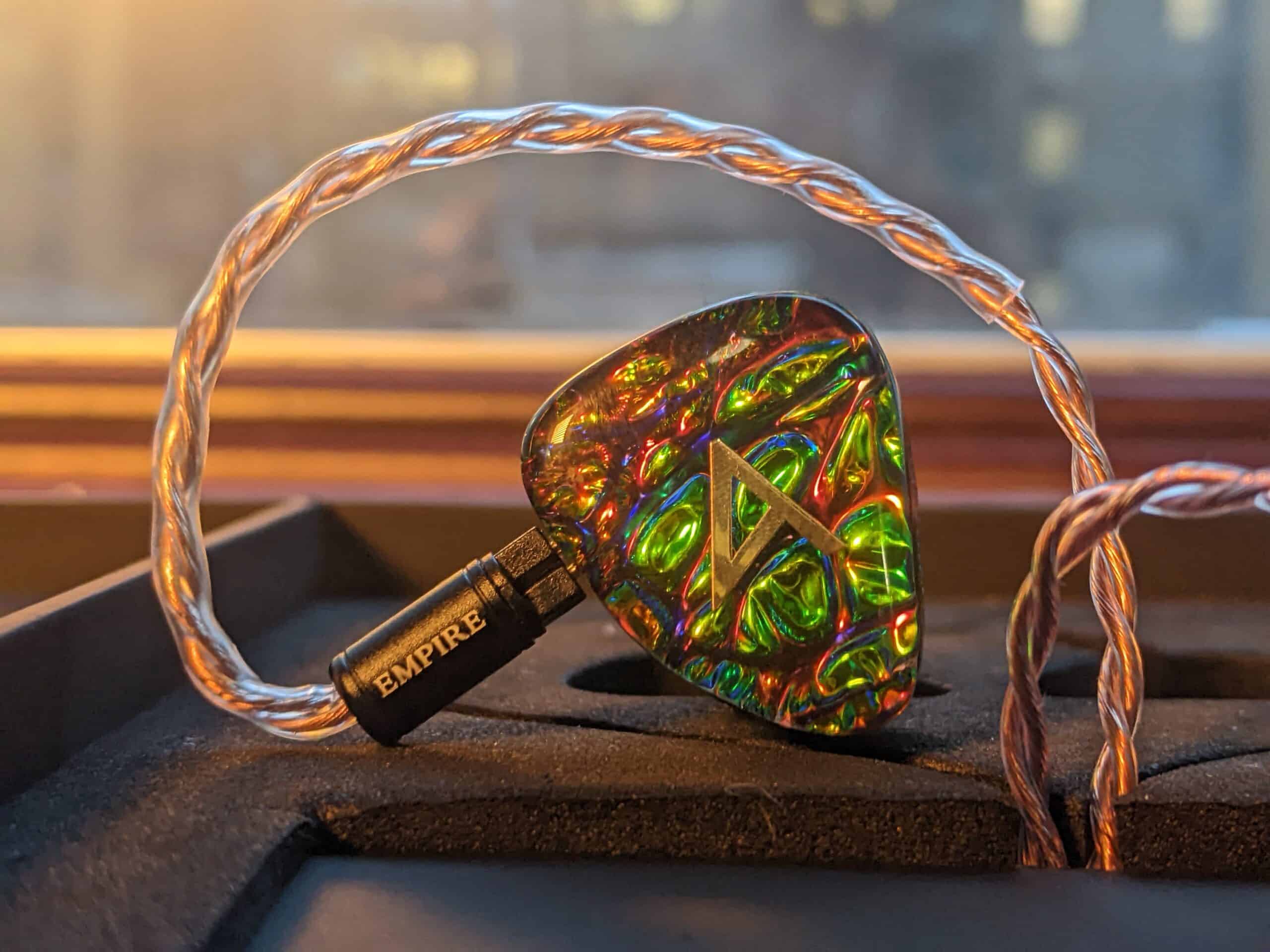
Overall
The Empire Ears x Astell&Kern Odyssey has fun imaging and a great balance throughout, but at the end of the day, it’s all about the bass – and I really mean The Bass. While keeping a critical ear for the mids and treble, there was constantly some low end part in a mix that would come thundering along the sides of my head and demand my attention. The Odyssey doesn’t just vibrate, or rumble: it ripples, completely pulling a listener into its undertow and pushing them to the bottom of the ocean floor. It’s an incredibly heady and addictive listening experience that gave me a craving for the deepest possible sounds that I could find on my test playlist. The concentration on sub and mid bass over high bass allows it to retain excellent clarity and detail in the midst of its power, allowing me to feel its lows and hear its mids and highs. I’m generally very excited to see bone conduction drivers in IEMs, and loved to hear how the Odyssey masterfully incorporated it. So, is it worth the $3,399? Decide for yourself, but Empire Ears x Astell&Kern’s Odyssey gave me a listening experience unlike any in-ear monitor that I’ve heard – or felt – in a while.
Purchase and/or read more about the Empire Ears x Astell&Kern Odyssey here from Audio46.

| Pros | Cons |
| Powerful and articulate subs and bass
Detailed and clean treble Vivid and truly unique imaging Great use of bone conduction Stylish and flashy Good accessories |
Expensive
Some people might find the balance artificial |
Compare the ranking of various headphones, earbuds and in-ear monitors using our tools.
Discuss this, and much more, over on our forum.
---MAJORHIFI may receive commissions from retail offers.


